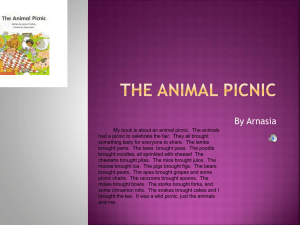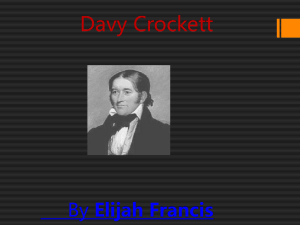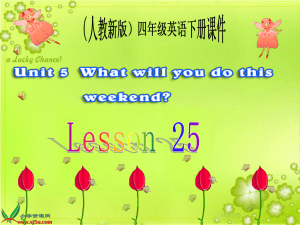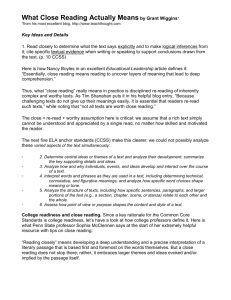March 16-20 Were Going on a Picnic with SS SC Lesson 22
advertisement
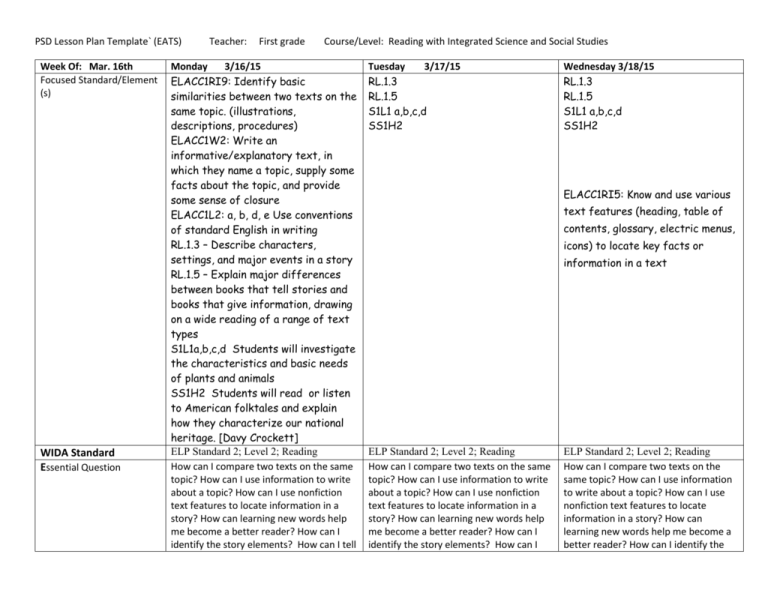
PSD Lesson Plan Template` (EATS) Week Of: Mar. 16th Focused Standard/Element (s) WIDA Standard Essential Question Teacher: First grade Course/Level: Reading with Integrated Science and Social Studies Monday 3/16/15 ELACC1RI9: Identify basic similarities between two texts on the same topic. (illustrations, descriptions, procedures) ELACC1W2: Write an informative/explanatory text, in which they name a topic, supply some facts about the topic, and provide some sense of closure ELACC1L2: a, b, d, e Use conventions of standard English in writing RL.1.3 – Describe characters, settings, and major events in a story RL.1.5 – Explain major differences between books that tell stories and books that give information, drawing on a wide reading of a range of text types S1L1a,b,c,d Students will investigate the characteristics and basic needs of plants and animals SS1H2 Students will read or listen to American folktales and explain how they characterize our national heritage. [Davy Crockett] ELP Standard 2; Level 2; Reading How can I compare two texts on the same topic? How can I use information to write about a topic? How can I use nonfiction text features to locate information in a story? How can learning new words help me become a better reader? How can I identify the story elements? How can I tell Tuesday 3/17/15 RL.1.3 RL.1.5 S1L1 a,b,c,d SS1H2 Wednesday 3/18/15 RL.1.3 RL.1.5 S1L1 a,b,c,d SS1H2 ELACC1RI5: Know and use various text features (heading, table of contents, glossary, electric menus, icons) to locate key facts or information in a text ELP Standard 2; Level 2; Reading How can I compare two texts on the same topic? How can I use information to write about a topic? How can I use nonfiction text features to locate information in a story? How can learning new words help me become a better reader? How can I identify the story elements? How can I ELP Standard 2; Level 2; Reading How can I compare two texts on the same topic? How can I use information to write about a topic? How can I use nonfiction text features to locate information in a story? How can learning new words help me become a better reader? How can I identify the the difference between a fiction and nonfiction story? Science: What are some of the characteristics and basic needs of animals? Social Studies: How did American folktales characterize our national heritage? tell the difference between a fiction and non-fiction story? Science: What are some of the characteristics and basic needs of animals? Social Studies: How did American folktales characterize our national heritage? Activating Strategy Where would you like to take a hike? Science: Watch video Ants: Backyard Science Clip https://www.youtube.com/watch?v=d7Xq 2eQJgIc Share your picnic stories from the journal from the previous day. Science Review vocabulary from previous lesson. Teaching Opening (10-15 min) Preview “Mike and Spike Hike”, and discuss beginning, middle and ending of a story. Take a Picture walk through “We’re Going on a Picnic” Read aloud “We’ re Going On a Picnic”, question and check for understanding Introduce new sight words for the week by calling out clues and having the students to glue the words on a piece of paper, then illustrate, Review fiction and non-fiction stories, make a list of characteristics that makes “We’re Going on a Picnic “a fiction story. Compare “We’re Going on a Picnic” to “Ants” Use a Venn diagram to discuss the differences Work-Time Activities (4555 min) Science: Introduce close reading “Ants”. Make a list of words students don’t know the meaning to and use context clues to figure the words out. Social Studies: Introduce Davy Crockett to the class with a video about his life. After the video discuss facts the students may remember about him. Chart these. The KWL chart may be used. Read the Close passage about him. Underline or highlight any vocabulary Science: Close Reading - "Ants" Take passage out and re-read it, review the vocabulary terms from previous day and complete vocabulary sheet, students circle words in the passage and go over it together. Social Studies: Review the KWL chart or an anchor chart of facts about Davy Crockett. Reread and discuss the Close passage about him. Use the graphic story elements? How can I tell the difference between a fiction and nonfiction story? Science: What are some of the characteristics and basic needs of animals? Social Studies: How did American folktales characterize our national heritage? Pretend that you are going on the picnic like in the story, make a list of food that you would like to have at the picnic. Science: Watch time lapse video of ants digging a tunnel. https://www.youtube.com/watch?v=Gt RNBHM3DR0 Read “We’re Going on a Picnic”, Focus on important facts that make this a fiction story. Use website to locate new information about ants for chart Using the nonfiction text features chart, locate key details and facts about ants in the stories provided. Make a chart of facts. Begin writing an informational piece about ants. Science: Close Reading - "Ants" Read the passage again as a whole group, complete the comprehension page by going through each question together and answering them while highlighting the evidence from the text to support each answer, high group may be able to discuss and complete within their group, keep redirecting toward the text to prove their answers. words that the students had difficulty with. https://www.youtube.com/watch?v=3 GOxrFPOFY8&list=PLlhtZwLR_s31k wdglqhLZvNmgr4FhcthC organizer to define and illustrate those new words. Add any new facts about him to the anchor chart. View a video or read a book about his life. Biography- part 1 (14:33) https://www.youtube.com/w atch?v=yWiXJlOK5Nk Differentiation Offered All Lessons Monday are Whole Group for Introduction Comparing texts assignment: “We’re Going on a Picnic” / “Ants” On level and above- work independently to compare the texts Below- work in small group with teacher to discuss differences in texts and fill out chart together Ticket out the door (Assessment) Summarizing Closure Activity (20-30 min) Journaling: Have you ever been on a picnic Journaling: Who would you like to go on a before? Tell me about it picnic with you? Why? Focused Standard/Element (s) Thursday RL.1.3 RL.1.5 3/19/15 WIDA Standard Essential Question S1L1 a,b,c,d SS1H2 ELP Standard 2; Level 2; Reading How can I compare two texts on the same topic? How can I use information to write about a topic? How can I use nonfiction text features to locate information in a Friday 3/20/15 RL.1.3 RL.1.5 S1L1 a,b,c,d SS1H2 ELP Standard 2; Level 2; Reading How can I compare two texts on the same topic? How can I use information to write about a topic? How can I use nonfiction text features to locate information in a Social Studies: Review the chart and facts about Davy Crockett. Reread the Close passage about him. Begin to answer the comprehension questions. (Finish these on Thurs.) Students must PROVE their answers by finding the answer in the passage. Watch a video or read a book about him. Students may complete a noun/adjective page describing Davy Crockett. Biography- part 2 (15:11) https://www.youtube.com/watch?v=MxsaFIC3T4 We’re Going on a Picnic/ Ants When writing the informational piece, all students are working independently to put their thoughts on paper When they finish the rough draft, individual help will be offered as needed Students will use word wall and rubric to help with conventions of standard English Ticket out the door (Assessment) Journaling: I liked this story because _____________________________. Additional Notes Science: Social Studies: Video on Davy Crockett (show as grade level) story? How can learning new words help me become a better reader? How can I identify the story elements? How can I tell the difference between a fiction and nonfiction story? Science: What are some of the characteristics and basic needs of animals? Social Studies: How did American folktales characterize our national heritage? Activating Strategy Teaching Opening (10-15 min) Work-Time Activities (4555 min) Write a letter inviting a the person from journal from previous day on a picnic. Listen to “We’re Going on a Picnic” on cd Discuss problem/solution in story Review rough draft, edit, start final draft of informational piece Complete story elements (problem/solution) page for story Review all words for the week complete sight word sentences for daily grade Science: Read the MyOn book: together on the Smartboard. Discuss. Add to the anchor chart of facts about Ants. Social Studies: Reread the Close passage about Davy Crockett. Finish answering the comprehension questions from the passage. Students must PROVE their answers by finding the answer in the passage. Add any new facts about them to the anchor chart. Students may complete the sheet Davy Crockett Reality or Fantasy? by writing two things that could happen and two that could not. Biography- part 3 (11:40) story? How can learning new words help me become a better reader? How can I identify the story elements? How can I tell the difference between a fiction and non-fiction story? Science: What are some of the characteristics and basic needs of animals? Social Studies: How did American folktales characterize our national heritage? Review words Listen to “We’re Going on a Picnic” on cd Review all essential questions and charts about texts this week Take reading and language arts tests Science: Review the anchor chart from yesterday’s lesson. Read a library book or watch a video about Ants and add to the anchor chart any new facts. Social Studies: Review the anchor chart about Davy Crockett. Students may complete a fact page of four things they have learned about Davy Crockett. Watch a video listed in the lesson plan, if time permits. [grade level video] https://www.youtube.com /watch?v=cnOfMQ_r288 (48 min cartoon) Differentiation Offered https://www.youtube.com/w atch?v=56VGHjdVtOY Each group will use leveled readers or variety of texts to complete the task low – read with group and help from adult complete problem and solution level 1 graphic organizer on level: read with partner, problem and solution level 2 graphic organizer above: read alone, describe problem and solution graphic organizer by writing sentences and using details Summarizing Closure Activity (20-30 min) Ticket out the Door (Assessment) Journaling: What did you learn about this week? Author’s chair-choose a few students to share their writing from the week.
